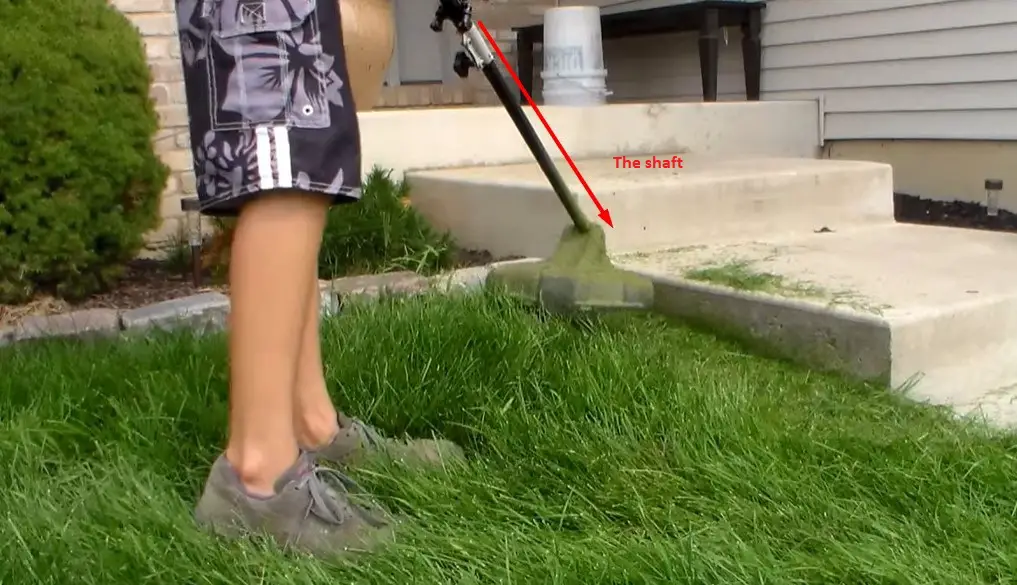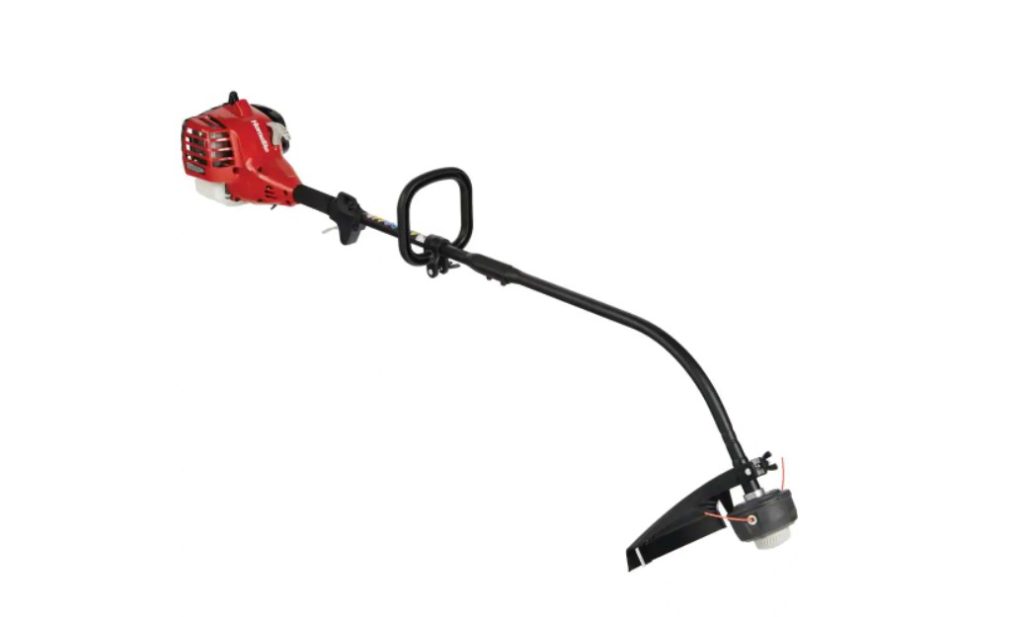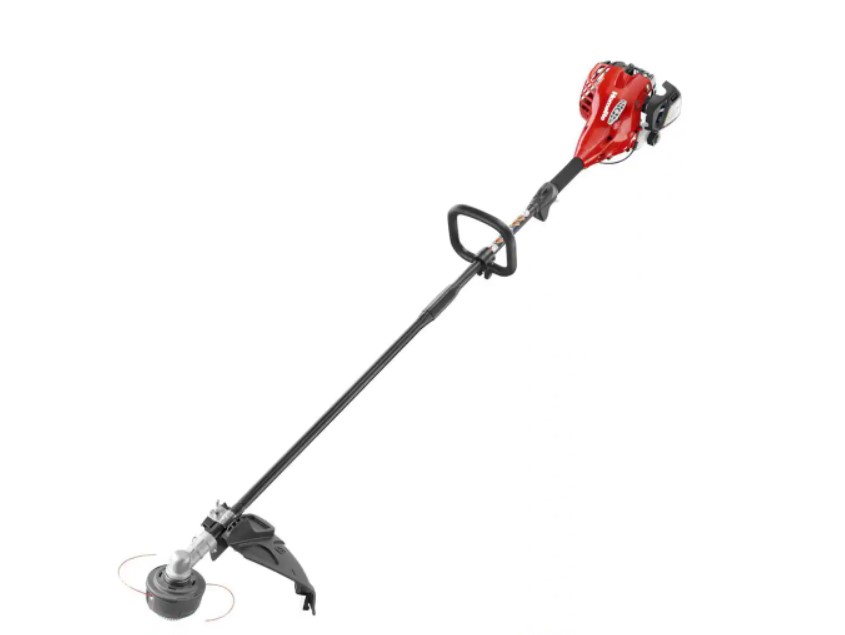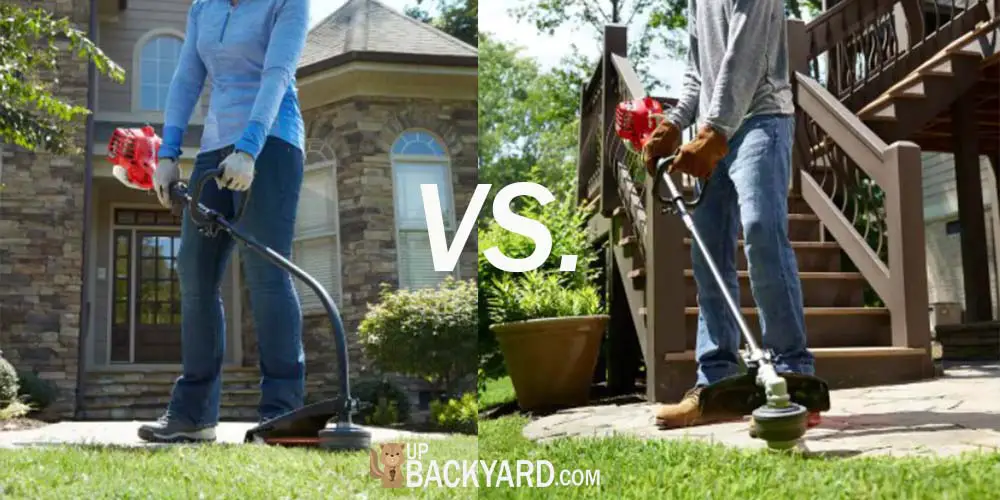All lawn care enthusiasts need a good string trimmer, but which one should you choose?
The truth is, a lot of people don’t realize that there are two different types of trimmers, and once you learn a little about each of them, it is easier to establish a favorite.
The shaft of the trimmer can be either straight or slightly curved, and if you’ve never noticed this difference before, just know that it does exist. Each of these trimmers has its own advantages and disadvantages, and it’s good to know what they are.
First Things First
Before we get into straight vs. curved shafts trimmer, it’s good to know a little about shafts in general. To begin with, in both of these trimmers – the shaft is considered the part where the throttle and handle are mounted. A drive cable runs the length of the shaft.

The cable spins due to the engine, then the cutting head near the other end turns the head that does the actual cutting, allowing it to work properly. One of the first things you need to know is that in curved shafts, the drive cable has to be very flexible.
Why? Because it has to accommodate that shaft’s curved shape, which also directly affects the cable’s durability. Since the drive cable continuously spins and bends within the shaft, it is given quite a workout each time you use it.
In practical terms, this means that curved shafts are often more likely to break than straight shafts since the straight shafts do not have cables that bend. But unless you use your trimmer constantly – say, as a professional – this shouldn’t be a concern because both shafts are overall very durable.
With straight shafts, there is no curve in the drive cable, so their driving mechanisms usually consist of steel cables, solid-steel drive shafts, or similar items.
Now, let’s take a look at some of the differences between straight vs. curved shaft string trimmers.
Curved Shaft Trimmers

We’ve already talked about one of the main differences between curved shaft and straight shaft trimmers: the durability of each, which is affected by the drive cable. Now let’s look at each of these trimmers in more detail.
First of all, trimmers with curved shafts are generally shorter than those with straight shafts. As a result, the trimmer is usually more lightweight and therefore easy to use when you have a longer job in front of you. If you’re short, all of these things might be beneficial to you.
Curved trimmers are usually less expensive than straight trimmers, so if your trimming jobs don’t take that long or they’re infrequent, these might be the trimmers for you.
Of course, curved shaft trimmers have their disadvantages as well. We’ve already mentioned that for frequent use, they may not be as durable. In addition, if you’re tall, the trimmers might require that you bend over as you work, which can be very uncomfortable and even painful.
Curved trimmers can also be cumbersome if you’re using them underneath a bush or patio furniture. They often will not accommodate any type of attachments, and they tend to use only lightweight nylon strings. The curved shaft trimmer also generates less torque and therefore has less cutting power.
Straight Shaft Trimmers

Overall, a straight shaft trimmer is more functional because, for one thing, it is longer and therefore easily accommodates even tall people. This alone can save a lot of back pain, especially if you use your trimmer for long periods of time.
Straight shaft trimmers have level drive lines and not bent ones, which result in less vibration and more power since there is also more torque generated. Whether the trimming job is long or short, a straight shaft trimmer tends to provide for a much more comfortable operation.
In addition, straight shaft trimmers allow you to use attachments if you need to, and you can even replace your nylon string with metal blades if you like. Even better, many of these trimmers allow you to remove the cutting edge and replace it with hedge clippers, pole saws, or edgers, among others.
On the downside, though, straight shaft trimmers usually weigh more and cost more than their curved shaft counterparts. They can feel more off-balance than the straight trimmers, and they can be difficult for users who are short or small in stature.
If you’re a professional, it’s probably best to choose a trimmer with a straight shaft instead of a curved one. Because of its versatility and its ability to accommodate both short and tall people, not to mention its durability, the straight shaft trimmer is usually more beneficial.
Comparing The Features of Each Trimmer
By now, you likely have an idea of which type of trimmer is best for you, but if you don’t, there’s no need to be concerned about it.
Below are some features and characteristics of both straight and curved grass trimmers so you can get a better idea of which one is right for you:
Balance and Weight
Whether your trimmer is powered by gas, electricity, or batteries, curved shaft trimmers are usually lighter than straight shaft trimmers.
Curved trimmers also tend to have better overall balance, in part because of their hook curve and their shorter length.
And since curved models usually have handles a little more strategically placed, it is often easier for the load of the unit to be supported when you’re using it for long periods of time.
Basic Power
Core power is especially important when you’re a lawn care professional. Most of the time, the horsepower (HP) of the unit tells you how powerful it is.
Simply put, straight shaft trimmers are more powerful because they have a gearbox and generate more torque. Curved shaft trimmers usually have no gearbox and generate less torque, which is why they are used frequently for personal use and straight shaft trimmers are used by commercial and industrial companies.
Longevity and Price
Ideally, you’ll want a trimmer that will last at least a few seasons. On average, trimmers with curved shafts are cheaper but not as durable as those with straight shafts.
Straight shaft trimmers tend to be better built and last longer, not to mention cheaper, but if you’re on a budget and/or rarely use your trimmer, it might be a good idea to save yourself some money and get a trimmer with a curved shaft.
Maneuverability
Both the weight and balance of the trimmer, which are discussed above, will affect its maneuverability. A trimmer that is easy to maneuver makes trimming certain areas, e.g., the edge of your flower bed, a lot easier. Reaching extended distances is also made easier with a unit that is easy to maneuver.
The best thing to do is decide exactly what type of maneuverability you need, then research the brands to find that type of trimmer.
Options With Your Cutting Head
Most trimmers have a cutting head that uses string, but you can also find them with metal blades instead.
Metal blades are perfect when you’re trimming underbrush or similar duties, but that doesn’t mean they are always necessary.
As a general rule, string is good for personal trimmers and even some commercial ones. Good commercial trimmers usually have the ability to use both string and metal blades.
Straight Shaft vs. Curved Shaft Trimmer – Which Is Better?
As you can see, there are both similarities and differences between these two types of trimmers. If you can’t make up your mind, the first thing you should consider is what you’ll be using the trimmer for when you head outside.
If you rarely use your trimmer or you only use it for short periods of time at your home, a curved shaft trimmer will do just fine.
On the other hand, if you use trimmers for long periods of time frequently, such as when you own your own lawn care business, a straight shaft trimmer is a much better option.
It’s also a good idea to test out the trimmer before you buy it. This doesn’t mean trimming your lawn with it, but at least pick it up and see how it feels in your hands. You can move it around to check out its maneuverability, its lightness, and its overall “feel.”
If your budget is a big concern or you’re shorter or smaller than average, the curved shaft trimmer is usually your best bet.
To be sure, there are a lot of things to consider when trying to choose between the two types of trimmers, but at least now you’ll know how to get started.
Final Thoughts
Lawn trimmers can have either straight or curved shafts, and they each have their share of advantages and disadvantages. If you intend to use your trimmer for professional or industrial use, you really need a trimmer with a straight shaft because they are more durable, more powerful, and more versatile.
People using trimmers for personal use can usually get by with a curved shaft trimmer, but if you simply prefer a trimmer with a straight shaft, you can certainly find one. In other words, the final decision has to be yours in the end.
